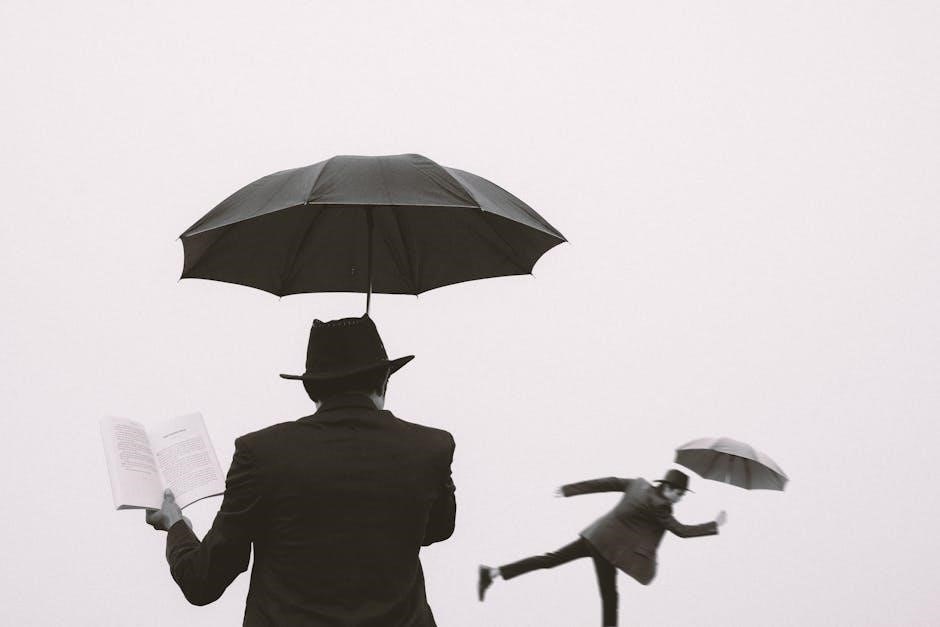Lord of the Flies, William Golding’s 1954 novel, explores how British schoolboys stranded on an island descend into chaos, revealing mankind’s inherent darker nature and societal constructs.
Overview of the Novel
Lord of the Flies, written by William Golding, tells the story of British schoolboys stranded on a tropical island after a plane crash. With no adult supervision, the boys initially attempt to create a utopian society but gradually descend into chaos, revealing their primal instincts. The novel explores themes of human nature, civility versus savagery, and the effects of isolation. As power struggles emerge, the group’s fragile order disintegrates, leading to terrifying consequences. This allegorical tale critiques societal norms and examines humanity’s darker aspects through the lens of youthful innocence gone awry.
William Golding and His Literary Significance
William Golding, a Nobel Prize-winning author, is renowned for his profound exploration of human nature in Lord of the Flies. His sparse, powerful prose and allegorical storytelling have made the novel a cornerstone of 20th-century literature. Golding’s military experience and philosophical insights shaped his writing, offering a bleak yet thought-provoking view of humanity. His work challenges readers to confront the duality of civility and savagery, cementing his legacy as a literary giant whose themes remain universally relevant and deeply unsettling;
Themes in “Lord of the Flies”
The novel explores human nature, civility vs. savagery, leadership, power struggles, and fear of the unknown, revealing how societal norms collapse without governance and morality.
Human Nature and the Duality of Civility vs. Savagery
Golding explores the inherent darkness in human nature through the boys’ descent from civility to savagery. Initially, they uphold societal norms, using the conch shell for order. However, fear and primal instincts gradually dominate, symbolized by their obsession with the “beast” and hunting. The novel illustrates how, without societal constraints, humanity’s civilized facade crumbles, revealing innate brutality. This duality highlights Golding’s belief that savagery is an intrinsic part of human nature, suppressed only by the rules of civilization.
Leadership, Power, and the Breakdown of Society
The novel examines the struggle for leadership and power among the boys, highlighting how societal structures collapse without adult supervision. Ralph, representing democracy and order, initially unites the group, while Jack’s authoritarian nature fosters division. The conch shell, a symbol of democratic discourse, loses its power as fear and savagery prevail. Golding illustrates how the pursuit of power corrupts, leading to a fractured society where dominance replaces cooperation. This breakdown reflects the broader human tendency to prioritize self-interest over collective well-being, underscoring the novel’s critique of societal hierarchies and leadership failures.
Key Characters in the Novel
Ralph, the democratic leader, represents order and civility. Jack, the power-hungry hunter, embodies primal instincts. Piggy, the intelligent voice of reason, symbolizes wisdom and logic. Simon, the quiet truth-seeker, uncovers the island’s dark secrets. Each character reflects aspects of human nature, driving the novel’s exploration of society and morality.
Ralph: The Symbol of Democracy and Order
Ralph, the fair-haired leader, embodies democracy and civility. He uses the conch shell to maintain order, symbolizing equality and justice. Initially, the boys rallied behind him, but as savagery rises, Ralph’s authority wanes. His struggle to uphold morality amidst chaos highlights the fragility of order without societal structures. Ralph’s descent into fear and isolation underscores the novel’s exploration of human nature, revealing the delicate balance between civilization and primal instincts.
Jack: The Representation of Primitive Instincts
Jack Merridew, the choir leader, evolves from a disciplined boy to a symbol of savagery. His obsession with hunting and desire for power reflect primal instincts. Jack’s descent into violence and manipulation, fueled by fear of the beast, showcases humanity’s darker tendencies. His leadership of the tribe emphasizes the collapse of civility, as he prioritizes survival over morality. Jack’s transformation highlights Golding’s exploration of how societal constraints suppress humanity’s inherent savagery, revealing the primal nature lurking beneath the surface of civilization.
Symbolism in the Novel
William Golding employs symbols like the conch shell, representing democracy, and the beast, symbolizing fear, to explore societal and human nature themes, highlighting primal instincts and evil through the Lord of the Flies.
The Conch Shell as a Symbol of Democracy
The conch shell in Lord of the Flies symbolizes democracy and order. Found by Ralph, it grants the holder the right to speak, ensuring equality in discussions. Initially, it unites the boys, but as savagery grows, the conch loses its power, reflecting the decline of civility. The shell’s destruction mirrors the collapse of democratic ideals, emphasizing Golding’s critique of human nature’s tendency to abandon reason for chaos. This symbol underscores the tension between order and primal instincts, central to the novel’s exploration of society’s fragility.
The Beast: A Representation of Fear and the Unknown
The Beast in Lord of the Flies symbolizes the primal fear of the unknown, manifesting as a mysterious creature the boys believe inhabits the island. Initially dismissed by Ralph, the Beast becomes a shared paranoia, fueling their descent into savagery. It represents the inherent human fear of the unseen and the boys’ loss of rationality. The Beast’s legend grows, dividing the group and leading to violent actions, ultimately highlighting the fragility of civility. Golding uses the Beast to explore how fear can dismantle order, reflecting the darker aspects of human nature and societal collapse.

William Golding’s Writing Style
Golding’s vivid imagery and allegorical storytelling in Lord of the Flies create a gripping narrative, blending excitement with profound insights into human nature and societal collapse;
Use of Imagery and Allegory
Golding’s masterful use of imagery and allegory transforms the island into a microcosm of society. The conch shell symbolizes democracy, while the “beast” embodies primal fears. Vivid descriptions of nature, like the lagoon’s beauty and the jungle’s darkness, mirror the boys’ internal struggles. Allegorical elements, such as the pig’s head (Lord of the Flies), represent evil and corruption. Golding’s imagery-rich prose creates a layered narrative, blending literal and symbolic meanings to explore humanity’s duality, making the novel a profound allegory of civilization’s fragility and the darkness within.
Themes of Morality and Ethics
In Lord of the Flies, Golding explores morality and ethics through the boys’ descent into chaos. The novel highlights the loss of moral constraints when societal rules disappear. The absence of adult supervision accelerates their moral decay, as primal instincts overshadow ethical behavior. Golding examines the struggle between inherent evil and the potential for goodness, suggesting that morality is a fragile construct. The boys’ actions reveal the thin line between civility and savagery, underscoring the novel’s central theme: the darkness within human nature and the necessity of societal structures to maintain ethical order.

Background and Historical Context
Lord of the Flies, published in 1954, reflects Cold War anxieties and post-WWII disillusionment. Its backdrop of nuclear war mirrors global fears, while the boys’ evacuation from Britain highlights societal collapse scenarios, grounding the novel in its historical era.
Golding’s Inspiration for the Novel
William Golding drew inspiration from his experiences as a naval officer in World War II and his observations of human behavior. The idea of boys stranded on an island emerged from his fascination with exploring the inherent nature of humanity without adult supervision. The novel was also influenced by the post-war era’s existential dread and the Cold War’s climate of fear. Golding’s teaching career and interest in psychology further shaped his portrayal of the boys’ descent into savagery, reflecting his pessimistic view of human morality.
The Novel’s Publication and Reception
Lord of the Flies was published in 1954 by Faber and Faber and initially met with mixed reviews; Critics found its themes of human savagery controversial, yet its unique narrative style and moral depth gained attention. Over time, the novel became a literary classic, celebrated for its exploration of human nature and society. Its popularity grew significantly in the 1960s, and it has since been translated into numerous languages, solidifying its place as a cornerstone of 20th-century literature and earning Golding the Nobel Prize in 1983.

Impact of “Lord of the Flies”
Lord of the Flies is a literary classic, influencing countless works and sparking debates on human nature. Its themes resonate globally, making it a cornerstone of 20th-century literature.
Cultural and Literary Influence
Lord of the Flies has left an indelible mark on literature and culture. Its exploration of human nature has inspired countless works, from films to stage adaptations. The novel’s themes resonate globally, making it a cornerstone of modern literature. Its influence extends beyond books, shaping discussions on morality and society. Translated into many languages, it remains a vivid reflection of human behavior, continuing to captivate audiences and inspire new adaptations across various media.
Adaptations and Interpretations
Lord of the Flies has been adapted into films, stage plays, and radio dramas,each interpreting its themes uniquely. A 1990 film version brought the story to life cinematically, while stage adaptations emphasize its dramatic tension. The novel’s timeless themes have inspired reinterpretations across cultures, reflecting its universal appeal. Its exploration of human nature continues to captivate audiences, making it a versatile work for various artistic mediums. These adaptations highlight the novel’s enduring relevance and its ability to resonate with diverse audiences.

Educational Significance
Lord of the Flies is a cornerstone of high school and college curriculums, provoking thought on civility, morality, and humanity. Its rich themes and moral dilemmas engage students deeply.
Teaching the Novel in Schools
Lord of the Flies is widely taught in schools for its exploration of human nature, civility, and savagery. Educators use the novel to prompt discussions on morality, leadership, and societal structures. Its themes of power struggles and ethical dilemmas resonate with students, encouraging critical thinking. Teachers often incorporate study guides and PDF resources to analyze key passages and themes. The novel’s allegorical nature makes it a valuable tool for teaching literary analysis and fostering empathy. Its relevance to adolescent experiences ensures engagement and deeper understanding of complex societal issues.
Analysis of Key Passages and Themes
Analyzing key passages in Lord of the Flies reveals its central themes of human nature, civility, and savagery. The conch shell symbolizes democracy, while the beast embodies fear of the unknown. Passages like the boys’ initial assembly and the hunt for the pig showcase their descent into chaos. Educators often highlight these moments to explore how Golding uses imagery and allegory to critique societal norms. These analyses help students understand the novel’s deeper messages about morality, power, and the fragility of civilization, making it a rich text for educational exploration and thematic study.